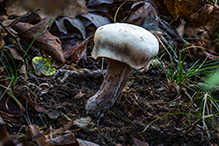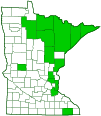Silvery-violet Cort
(Cortinarius alboviolaceus)
Conservation • Description • Habitat • Ecology • Distribution • Taxonomy
|
|
||||||||||||||
Description |
Silvery-violet Cort is a common, small to medium-sized, webcap mushroom. It occurs in Europe and North America. In the United States, it occurs in the east from Maine to Florida, west to Minnesota and eastern Texas. In the west it occurs on the coast from northern Washington to central California, and the range extends up the coast into Alaska. A separate (disjunct) population occurs in Colorado. It is one of the most common species in the very large genus Cortinarius. It is less common in Minnesota, where it reaches the western extent of its eastern range. Silvery-violet Cort is found in late summer and fall, in deciduous forests, alone, scattered, or in groups but not clustered (gregarious). It grows on the ground attached to the roots of hardwoods. It obtains its nutrients from the rootlets of living trees (mycorrhizal). When it first appears, the cap is convex to broadly bell shaped, silvery violet, and covered with silk-like fibers, remnants of the universal veil. As it ages, it broadens, the color fades, the surface becomes silky and shiny, and the margins turn outward, giving the cap a somewhat helmet-like appearance. The mature cap is 1¼″ to 3″ (3 to 8 cm) in diameter. It may be broadly bell shaped, with a broad, central bump, or nearly flat. The surface is dry, satiny, and pale silvery violet, whitish lilac, or whitish. The gills are closely spaced. They may be narrowly attached to the stalk, broadly attached, or notched at the stalk. They are pale violet or whitish at first, but they become cinnamon brown to rusty brown as the spores ripen. The stalk is 1½″ to 4¾″ (4 to 12 cm) long and 3⁄16″ to ⅜″ (5 to 10 mm) thick at the top. It is usually club shaped or swollen at the base. The upper part is dry, silky, and violet or pale violet. The lower part is yellowish but is covered with whitish silky fibers. The fibers may appear brownish as they trap mature spores fallen from the gills. The base of the stem is “booted”, sheathed with white, thin, soft, silky material of the universal veil. The flesh is whitish or pale violet. The odor is mild. The edibility is unknown, but it should be avoided due to its similarity in appearance to other poisonous mushrooms. The spore print is rusty brown. |
Similar Species |
Habitat and Hosts |
Deciduous forests |
Ecology |
Season |
Common but not abundant |
Distribution |
||
|
Sources |
|
| 3/19/2024 | ||
Occurrence |
||
|
||
Taxonomy |
|
Kingdom |
Fungi (Fungi) |
Subkingdom |
Dikarya |
Phylum |
Basidiomycota (Basidiomycete Fungi) |
Subphylum |
Agaricomycotina (Higher Basidiomycetes) |
Class |
Agaricomycetes (Mushrooms, Bracket Fungi, Puffballs, and Allies) |
Subclass |
Agaricomycetidae |
Order |
|
Suborder |
Agaricineae |
Family |
Cortinariaceae |
Genus |
Cortinarius (webcaps) |
Subgenus |
Telamonia |
Section |
Firmiores |
|
|
Cortinarius alboviolaceus was first described in Europe in 1801, then later reported widely in North America. It is likely that Cortinarius alboviolaceus is restricted to Europe, and in North America there is a group of two or more distinct species similar to it, but further study is needed to separate them. |
|
Subordinate Taxa |
|
|
|
Synonyms |
|
Agaricus alboviolaceus Cortinarius alboviolaceus var. fuscoviolaceus Cortinarius fuscoviolaceus Cortinarius fuscoviolascens Cortinarius griseoviolaceus Cortinarius mixtus Cortinarius mixtus var. foetulentus Cortinarius mystagogi Cortinarius radicatoviolaceus Cortinarius radicatoviolaceus f. glutinocephalus Gomphos alboviolaceus Inoloma alboviolaceum Inoloma alboviolaceum Phlegmacium alboviolaceum Sphaerotrachys alboviolaceum |
|
Common Names |
|
Pearly Webcap (UK) Silvery-violet Cort Silvery-violet Cortinarius |
|
Glossary
Mycorrhizal
A symbiotic, usually beneficial relationship between a fungus and the tiny rootlets of a plant, usually a tree.
Universal veil
An egg-like structure that envelopes all or most of a developing gill mushroom. Remnants of the universal veil sometimes visible on a mature mushroom are patchy warts on the cap, a ring on the stem, and a volva at the base of the stem.
Visitor Photos |
||
Share your photo of this fungus. |
||
This button not working for you? |
||
Robert Briggs |
||
 |
|
|
MinnesotaSeasons.com Photos |
||
|
||
|
||

Slideshows |
|

Visitor Videos |
||
Share your video of this fungus. |
||
This button not working for you? |
||
ContributorName |
|
Other Videos |
||
Weißvioletter Dickfuß, Cortinarius alboviolaceus |
About
Nov 18, 2018 Pilzportrait: Weißvioletter Dickfuß, Cortinarius alboviolaceus - |

|
Created: 3/19/2024 Last Updated: © MinnesotaSeasons.com. All rights reserved. |


